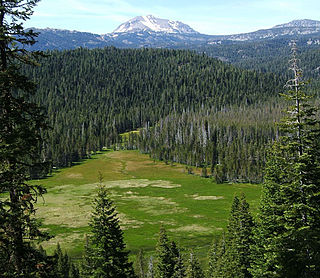Loading AI tools
Watershed of the Feather River From Wikipedia, the free encyclopedia
The Feather Headwaters is the watershed of the Feather River above Lake Oroville, totaling 3,450 sq mi (8,900 km2). Subdivided into 3 watersheds, the North Fork Feather Watershed is 1,090 sq mi (2,800 km2)—including the West Branch drainage of about 282.5 sq mi (732 km2), the East Branch North Fork Feather Watershed is 1,010 sq mi (2,600 km2),[1] and the Middle Fork Feather Watershed is 1,350 sq mi (3,500 km2)[1]—including the South Fork drainage of about 132 sq mi (340 km2).[2] Headwaters drainage is impaired by the Palermo Canal at Oroville Dam, the Hendricks Canal at the West Branch Feather River, and the Miners Ranch Canal at the South Fork's Ponderosa Reservoir. Additionally, the Pacific Gas and Electric Company releases Upper Feather water into the Hyatt Generating-Pumping Plant for hydroelectric generation during daily peak demand.[specify]
This article's use of external links may not follow Wikipedia's policies or guidelines. (October 2023) |

The North Fork Feather Watershed (USGS huc 18020121) includes the West Branch and North Fork rivers and receives flow from the East Branch North Fork Feather Watershed.
The East Branch Feather Watershed (USGS huc 18020122) is the middle watershed of the headwaters of the Feather River basin and includes the American and Indian valleys.
The Middle Fork Feather Watershed (USGS huc 18020123) includes the Middle Fork Feather River, the Fall River, and the South Fork Feather River; as well as the Grizzly Valley
The broad drainage divide of the Feather Headwaters lies northwest-to-southeast along 1) the divide with the Lower Pit Watershed (north of the North Fork Feather Watershed), 2) the Great Basin Divide at the Eagle-Honey Watershed (north & northeast of the North Fork Feather Watershed), 3) the northern Sierra Crest (northeast of the North Fork Feather & East Branch North Fork Feather watersheds), and 4) the northern Sierra Crest (east of the Middle Fork Feather Watershed) to the Truckee Watershed triple point in Sierra County.[8]
The Maidu inhabited the American and Sierra Valleys and had villages in the Big Meadows area (now Lake Almanor) and Indian Valley. The Washoe hunted in the Sierra and Mohawk Valleys, and Paiute and Washoe settlements were in the Long Valley area.[9] The 1849 California Gold Rush brought thousands of prospectors and settlers to the region. The American and Indian Valleys were settled in the 1850s. In the Sierra Valley the first settlers arrived in 1852.[9] Operations at the Lime Saddle and Coal Canyon hydroelectric powerhouses along the North Fork began August 1, 1906, and December 24, 1907.[10] The 1909 Feather River Route was built through the Feather River Canyon along the North Fork and East Branch and crossed under the mid-Sierra drainage divide between the East Branch and Middle Fork watersheds via the Spring Garden tunnel. Other historical Feather River Route features (west-to-east) in the Feather Headwaters are the Keddie Wye, Williams Loop, Clio trestle, & Chilcoot Tunnel.
Seamless Wikipedia browsing. On steroids.
Every time you click a link to Wikipedia, Wiktionary or Wikiquote in your browser's search results, it will show the modern Wikiwand interface.
Wikiwand extension is a five stars, simple, with minimum permission required to keep your browsing private, safe and transparent.